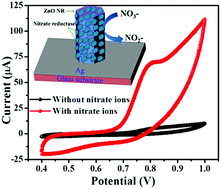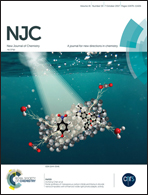Fabrication of a robust and highly sensitive nitrate biosensor based on directly grown zinc oxide nanorods on a silver electrode
Abstract
Herein, we report fabrication of a robust and highly sensitive nitrate biosensor based on directly grown zinc oxide nanorods (ZnO NRs) on an electrode surface. As-grown ZnO NRs on the electrode surface provided an excellent matrix for nitrate reductase (NaR) immobilization by the physical adsorption method, which was used as a potential biosensor for nitrate detection. The fabricated biosensor demonstrated a high sensitivity of 450.5 μA mM−1 cm−2, a wide linear range from 1.0 μM to 3.4 mM, fast response time of ∼3 s, and a low detection limit of 1.0 μM (S/N = 3) for nitrate sensing. The anti-interference ability, reproducibility, and long-term stability of the biosensors were also assessed. The obtained results demonstrated that this biosensing strategy not only has great promise for the sensitive and stable detection of nitrate ions but also can be conveniently expanded for different analyte detection by changing enzymes. More importantly, vertically grown ZnO NRs provide a high surface area for enzyme immobilization and excellent reproducibility. The applicability of the proposed biosensor was demonstrated in real water samples to detect nitrates. The results were satisfactory based on the recovery of the known nitrate concentrations spiked in tap and pond water samples.



 Please wait while we load your content...
Please wait while we load your content...